
Imagine that a person has asked for your help in working towards achieving their career goals. You can start by creating an encouraging environment.
If appropriate, you can then focus on the following themes to help the person to achieve peak performance.
Achievement
Imagine that a person has said they want to shape their future career. Before settling on their goals, it can be useful to invite them to explore the following questions.
“What are the things you want to do in your career? What are kinds of work you find most satisfying? What are the specific things you find satisfying when doing these kinds of work?
“Imagine you had a blank piece of paper and could create your ideal job. Describe three things you would love to have in such a role.
My Ideal Work Would Be Where:
*
*
*
“Let’s move into the future. Imagine you are looking back at the end of your career. What do you want to have achieved by then? What for you will mean that you have had a satisfying career?”
You can start by exploring what the person wants to do. If appropriate, you can also think about what you believe they can achieve. How to clarify their possibilities?
One approach is to ask yourself some of the following questions when looking at a person or an example of their work.
When does the person show positive energy? What are the person’s strengths? When do they do satisfying work? What do they do right then? How can they follow these principles in the future?
Bearing in mind what I have seen, what do I believe it may be possible for the person to achieve? What are the reasons why I believe they can achieve these things?
Good coaches, for example, often focus on what they believe a person can achieve. They then check whether such aims resonate with the person. They may say something like the following.
“As far as I understand it, you want to … Is that right? Let me ask you a question. Would you also like:
1) To …
2) To …
3) To …
“The reason I ask is because, from what you have said and the things I seen, I believe you could do those things.
“This would involve you choosing to set certain goals and do the necessary work. But I believe that you could achieve those goals. What do you think?”
Imagine that you have shared some of these ideas with the person. It will then be time to settle on the goals they want to achieve. Bearing this in mind, you may say something along the follow lines.
“Looking at the various possibilities, which of these themes would you like to focus on? What are the specific goals you would like to work towards?
“Let’s focus on your chosen goal. Looking at this, what are the real results you want to achieve? What is the picture of success? What will be the benefits of achieving these aims?”
Imagine that you are working with a person who has asked for your help in shaping their career. How can you clarify their aspirations? How can you then help them to settle on the specific goals they want to achieve?
If you wish, try tackling the exercise on this theme. This invites you to complete the following sentences.
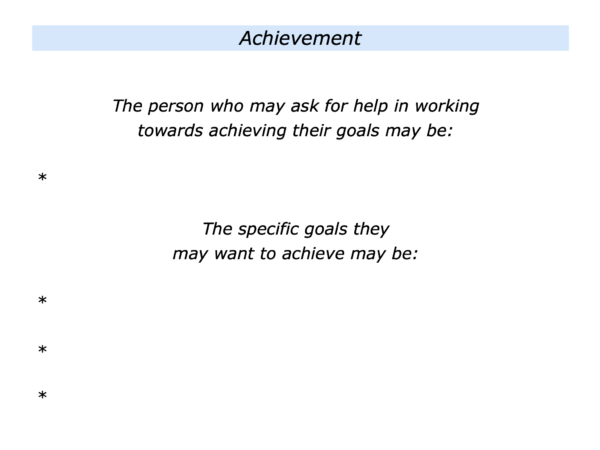
Attitude
Imagine that a person wants to achieve certain goals. They may want to do this when working as a writer, actor, business leader, footballer or in another professional role.
What attitude must they demonstrate to succeed? Depending on their chosen activity, they may need:
To be positive … To be kind … To want to learn … To be proactive … To think ahead … To be resilient … To have a sense of perspective … To be patient … To be committed to continuous improvement.
Some people may already have the required attitude. Some people may need to choose if they wish to demonstrate these qualities. A person can choose:
To be positive or negative … To be a creator or a complainer … To take responsibility or avoid responsibility … To help people or hurt people … To do their best or not to do their best.
Will the person be working alone or with other people? If the latter, then it is important to ask the following questions.
What is the person’s style of interacting with other people? How do they communicate with and relate to people? What are the consequences of the person’s style? How do people feel after interacting with them? What will be the effect they have on their colleagues, customers and other stakeholders?
Imagine that you are helping somebody to work towards achieving their aims. Looking at their behaviour, ask yourself:
What is the attitude the person must demonstrate to achieve their goals? On a scale 0-10, to what extent do they demonstrate this attitude?
When have they demonstrated these qualities in the past? How can they demonstrate these qualities in the future? How can I help them to maintain or develop the required attitude?
If you wish, try tackling the exercise on this theme. This invites you to complete the following sentences.
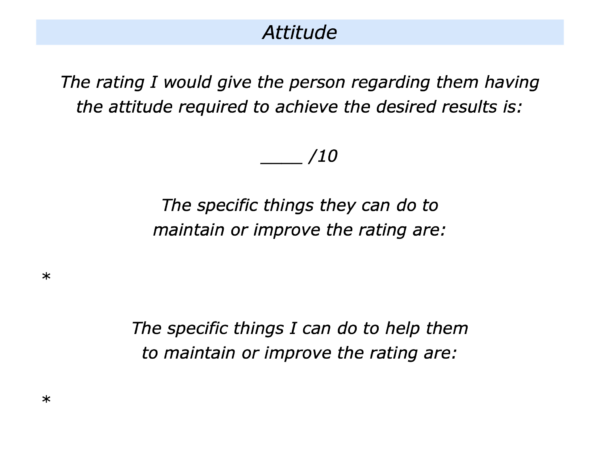
Ability
Imagine the person wants to work as a counsellor, singer, football manager, scientist, lawyer, developer, salesperson, business owner or in another role. What are the abilities they must demonstrate?
Depending on their chosen activity, they may need to score highly in the following areas:
To encourage people … To have certain professional skills … To think strategically … To be able to see patterns … To be a problem solver … To enable other people to perform at their best … To build superb teams.
How to clarify whether the person has such abilities? One approach is to explore their positive history and invite them to do the following things:
To describe two satisfying and successful projects they have done in their life;
To describe what made each of these satisfying;
To describe the actual things they did – in behaviour terms – to deliver success.
Look for any recurring patterns. These can give clues to a person’s successful style of working. Imagine you have clarified some of the person’s abilities. It can be useful to ask yourself the following questions.
What are the specific abilities they need to demonstrate to reach their goals? On a scale 0-10, to what extent do they have these abilities? What can they do to maintain or improve the rating?
If you wish, try tackling the exercise on this theme. This invites you to complete the following sentences.
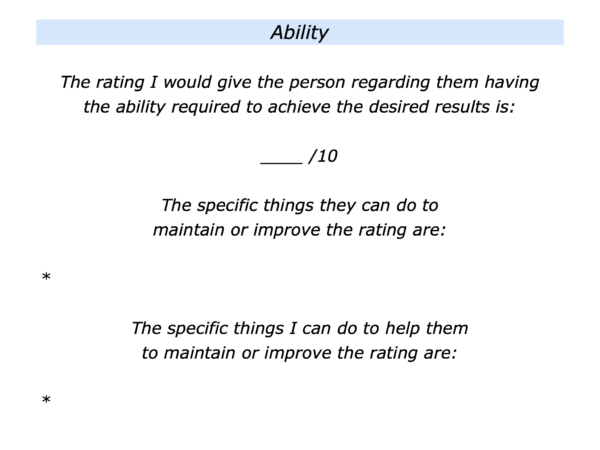
Application
A person’s attitude and ability provide a good foundation for them working to achieving success. It will then be important for them to apply themselves fully to the task.
Depending on their chosen activity, they may need to score highly in the following areas:
To have the necessary drive … To be self-disciplined and self-managing … To follow their chosen strategies … To keep doing the right things in the right way every day … To do superb work … To find solutions to challenges … To help their customers and colleagues to succeed.
Let’s return to the person you may be helping. Bearing in mind the person’s chosen activity, it can be useful to ask yourself the following questions.
Does the person apply themselves when tackling their chosen activity? Do they prepare properly? Do they rehearse when they are going to do? Do they clarify their chosen strategies? Do they anticipate the potential challenges?
Does the person follow rituals before embarking on the activity? Do they then immerse themselves fully? Do they keep following the right strategies in the right way?
Do they build on their strengths and manage the consequences of any weaknesses? Do they apply their skills in the right way? Do they keep reading reality? Do they keep improving?
If you wish, try tackling the exercise on this theme. This invites you to complete the following sentences.
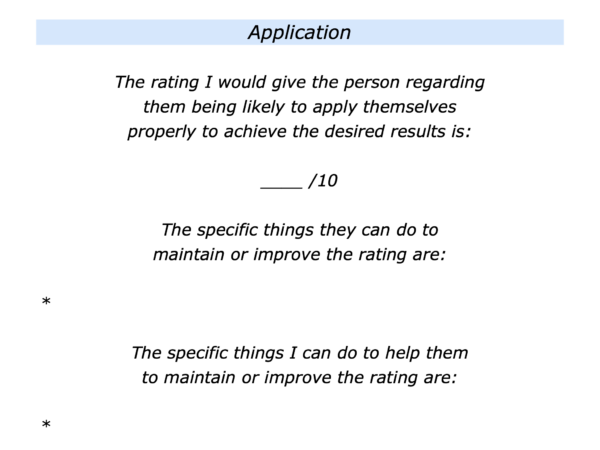
Adventure
Application will get a person so far and that may be enough to reach the goals. On some occasions, however, they may need to dare to adventure.
Great workers always do the basics and then add the brilliance. Bearing this in mind, the kinds of adventure a person needs to demonstrate will depend on the activity they are doing.
Sometimes it may involve being consistent and then being creative. Sometimes it may involve being disciplined and then choosing to be daring to deliver the goods. Sometimes it may involve finding solutions to challenges.
How to find clarify whether a person can demonstrate this sense of adventure? You can ask yourself the following questions.
What are the real results the person are aiming to achieve when doing their chosen activity? When may they need to be creative or find solutions to challenges? When may they need to be daring and demonstrate a sense of adventure to achieve their goals?
What are the kinds of qualities they may need to demonstrate when taking this step? When have they shown these qualities in the past? What were the principles they followed then? How can they follow similar principles – plus add other skills – in the future?
What may be the specific situations where they need to demonstrate this ability? What can they then do to make good decisions and, when appropriate, show this sense of adventure? How can I help them to take these steps?
If you wish, try tackling the exercise on this theme. This invites you to describe the following things.
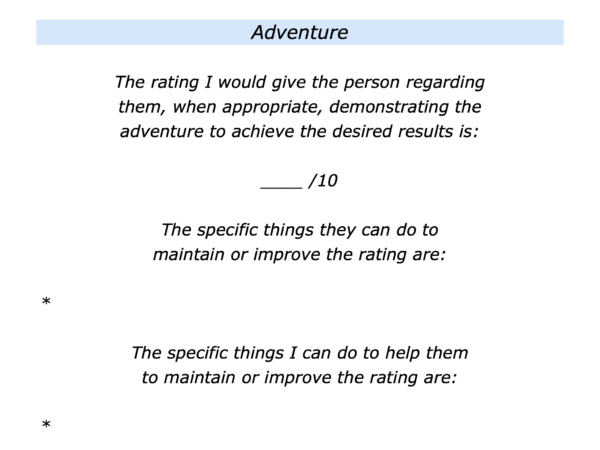
Achievement
Imagine that the person has demonstrated the right attitude, built on their abilities and applied themselves properly. There are many models for helping individuals to move from potential to peak performances.
Different people pursue this in different ways. Some do it be going into their version of the zone.
Michael Murphy and Rhea White described such experiences in their book In The Zone: Transcendent experiences in sports. They quoteMargherita Duncan writing about Isadora Duncan in the following way.
When she danced the Blue Danube, her simple waltzing forward and back, like the oncoming and receding waves on the shore, had such ecstasy of rhythm that the audience became frenzied with the contagion of it.
They could not contain themselves, but rose from their seats, cheering, applauding, laughing and crying.
How to clarify whether a person may be able to achieve their aims? You can ask yourself the following questions.
When does the person achieve their aims? When do they do their personal best? When do they go beyond 8+/10 – even for a short time – and achieve peak performance?
What are they doing right then? What are principles they are following? How do they translate these into action? How can they be helped to follow these principles in the future and achieve peak performance?
On a scale 0-10, how high would you rate the likelihood of the person achieving their chosen aims? What can they do to maintain or improve the rating? How may you be able to help them to take these steps?
If you wish, try tackling the final exercise on this theme. This invites you to complete the following sentences.
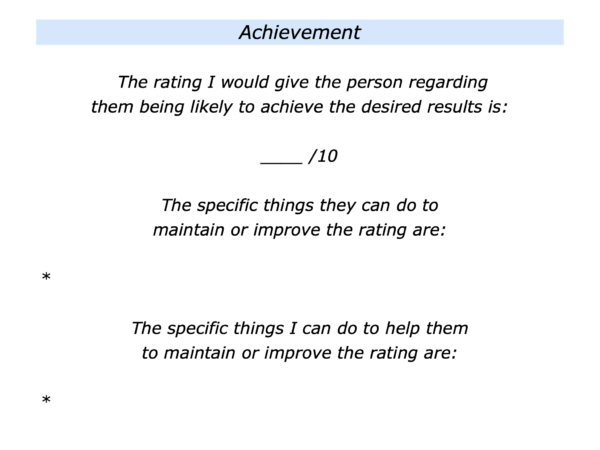






Leave a Reply